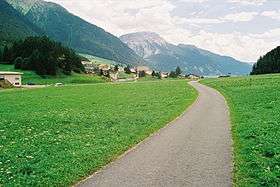Reschen Pass
| Reschen pass | |
|---|---|
|
Pass summit at Reschen, looking southwards | |
| Elevation | 1,504 m (4,934 ft) |
| Location | Austria–Italy border |
| Range | Alps |
| Coordinates | 46°50′53″N 10°30′18″E / 46.848°N 10.505°ECoordinates: 46°50′53″N 10°30′18″E / 46.848°N 10.505°E |
 Reschen Pass Location of the Reschen Pass | |
Reschen Pass (German: Reschenpass [ˈrɛʃn̩ˌpas]; Italian: Passo di Resia [ˈpasso di ˈrɛːzja]) is a mountain pass across the Main chain of the Alps, connecting the Upper Inn Valley in the northwest with the Vinschgau region in the southeast. Since 1919, the border between South Tyrol, Italy and Tyrol, Austria has approximately followed the watershed, the pass summit at a height of 1,504 metres (4,934 ft) being completely on Italian territory.
Location
Reschen is one of the principal passes of the Alps, located between Brenner Pass in the east and Viamala in the west. It is part of the drainage divide between the Danube in the north and the Adige in the south.
The village of Reschen (Resia) is directly located on the watershed, on the shore of the Reschensee reservoir, build in 1950 and famous for the bell tower which emerges from the water in front of Graun municipality. The border with Nauders, Austria runs about 2 kilometres (1.2 mi) north of the pass summit towards the tripoint with Valsot, Switzerland in the west.
History
Already before the Roman era, an unnamed bridle path linked the valley of the Inn River with the valley of the Adige (de. Etsch; lad. Adesc) river. The current Reschen Pass was part of the Via Claudia Augusta, opened about 50 AD. Later superseded by the Via Raetia across Brenner Pass, built at the behest of Emperor Septimius Severus in the 2nd century, it remained one of the few Roman roads leading into the Raetia province and to Augusta Vindelicorum. During the Middle Ages, the pass was an alternative to the passes of Graubünden in the west, though from the 14th century onwards the parallel Brenner Pass road from Bozen through the Eisack Valley in the east gained more and more importance.
Unlike the wide and smooth southern side, the northern side of Reschen Pass has a steep and narrow bottleneck at Finstermünz (1188 m). Archduke Sigismund of Austria had a fortress built here in 1472 and until 1854 a custom house between the Austrian County of Tyrol and Switzerland was founded between two fortified bridges over the Inn river.
The Austrian engineer Carl Ritter von Ghega (who already had built the Semmering railway line from Vienna trhough Lower Austria and Styria to Graz) and Joseph Duile laid out plans for a new road from the fortress of Nauders (1394 m) to Cajetansbrücke near Pfunds (972 m), which was built between 1850-54. This road leads to Reschen Pass along the Eastern, Austrian banking of the Inn, connecting the Austrians lands on Austrian soil. An additional mountain road leads from the Inn valley from the Swiss hamlet Martina resp. the Austrian Martinsbrück up to Norbertshöhe and Nauders, providing a shorter way from Switzerland to Italy compared to the longer road via Cajetansbrücke. Several structures for a projected railway connection were also built, however, these plans were finally abandoned after World War II.
See also
External links
| Wikimedia Commons has media related to Reschenpass. |
 Coolidge, William Augustus Brevoort (1911). "Reschen Scheideck". In Chisholm, Hugh. Encyclopædia Britannica. 23 (11th ed.). Cambridge University Press. p. 181.
Coolidge, William Augustus Brevoort (1911). "Reschen Scheideck". In Chisholm, Hugh. Encyclopædia Britannica. 23 (11th ed.). Cambridge University Press. p. 181.- Profile on climbbybike.com
